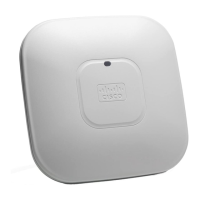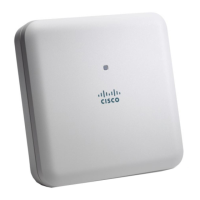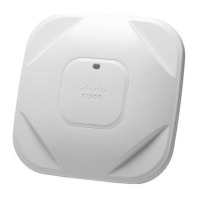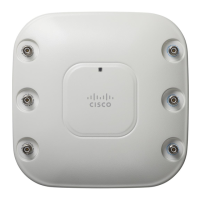Do you have a question about the Cisco Aironet 2802E and is the answer not in the manual?
Describes the capabilities and technologies of the Cisco Aironet 2800 Series APs.
Details specific model numbers and their corresponding regulatory domains for compliance.
Explains the dedicated and flexible radio configurations and antenna types.
Specifies the number and type of internal antennas used in the 2802I model.
Details the external antenna options and connectors available for the 2802E model.
Lists part numbers, descriptions, and gain for compatible external antennas.
Provides critical warnings regarding potential hazards and safe operating procedures.
Emphasizes the importance of retaining safety guidelines for future reference.
Explains how the access point locates and establishes communication with the controller.
Details the final steps for integrating the configured AP into the wireless network.
Explains the functionality and operations of the access point's mode button.
Highlights key considerations and best practices for APs managed by controllers.
Explains the FRA feature for dynamic radio band management.
Describes the purpose and use of the Smart Antenna connector.
Explains Link Aggregation support for increased uplink speed.
Describes the ClientLink 4.0 technology for improved wireless performance.
Addresses the current usability status of the USB port.
FCC compliance statement for the AP models.
Compliance statement for Japan's VCCI standards.
Rules for operating APs in Japan to avoid interference.
Compliance statement related to power accessories.
Information regarding Canadian regulatory compliance.
Specific compliance details for Canada.
Regulatory notes for European countries.
EU compliance with R&TTE and Medical Directives.
Information on compliance with radio frequency exposure guidelines.
General overview of RF exposure standards and compliance.
Details FCC requirements for RF exposure limits.
Details Industry Canada requirements for RF exposure limits.
Provides links for further RF exposure research.
Rules specific to operating APs in Taiwan.
Special information for operating APs in Brazil.
General statements on product conformity.
Describes the capabilities and technologies of the Cisco Aironet 2800 Series APs.
Details specific model numbers and their corresponding regulatory domains for compliance.
Explains the dedicated and flexible radio configurations and antenna types.
Specifies the number and type of internal antennas used in the 2802I model.
Details the external antenna options and connectors available for the 2802E model.
Lists part numbers, descriptions, and gain for compatible external antennas.
Provides critical warnings regarding potential hazards and safe operating procedures.
Emphasizes the importance of retaining safety guidelines for future reference.
Explains how the access point locates and establishes communication with the controller.
Details the final steps for integrating the configured AP into the wireless network.
Explains the functionality and operations of the access point's mode button.
Highlights key considerations and best practices for APs managed by controllers.
Explains the FRA feature for dynamic radio band management.
Describes the purpose and use of the Smart Antenna connector.
Explains Link Aggregation support for increased uplink speed.
Describes the ClientLink 4.0 technology for improved wireless performance.
Addresses the current usability status of the USB port.
FCC compliance statement for the AP models.
Compliance statement for Japan's VCCI standards.
Rules for operating APs in Japan to avoid interference.
Compliance statement related to power accessories.
Information regarding Canadian regulatory compliance.
Specific compliance details for Canada.
Regulatory notes for European countries.
EU compliance with R&TTE and Medical Directives.
Information on compliance with radio frequency exposure guidelines.
General overview of RF exposure standards and compliance.
Details FCC requirements for RF exposure limits.
Details Industry Canada requirements for RF exposure limits.
Provides links for further RF exposure research.
Rules specific to operating APs in Taiwan.
Special information for operating APs in Brazil.
General statements on product conformity.
| MIMO type | Multi User MIMO |
|---|---|
| Frequency band | 2.412 - 2.462, 5.18 - 5.32, 5.5 - 5.7 (excludes 5.6 - 5.64), 5.745 - 5.825 GHz |
| Channel bandwidth | 160 MHz |
| Channels quantity | 32 channels |
| Networking standards | IEEE 802.11a, IEEE 802.11ac, IEEE 802.11b, IEEE 802.11d, IEEE 802.11g, IEEE 802.11h, IEEE 802.11n, IEEE 802.1x, IEEE 802.3ad, IEEE 802.3at |
| Ethernet LAN data rates | 100, 1000 Mbit/s |
| Maximum data transfer rate | 5200 Mbit/s |
| Cyclic Shift Diversity (CSD) | Yes |
| Placement | Ceiling, Wall |
| Certification | UL 60950-1, CAN/CSA-C22.2 No. 60950-1, UL 2043, IEC 60950-1, EN 60950-1, EN 50155 |
| Product color | White |
| Cable lock slot type | Kensington |
| Security algorithms | 802.1x RADIUS, AES, EAP-FAST, EAP-PEAP, EAP-SIM, EAP-TLS, EAP-TTLS, MSCHAPv2, WPA, WPA2 |
| Operating altitude | 0 - 3000 m |
| Non-operating altitude | 0 - 4572 m |
| Storage temperature (T-T) | -30 - 70 °C |
| Operating temperature (T-T) | -20 - 50 °C |
| Operating relative humidity (H-H) | 10 - 90 % |
| Number of products included | 10 pc(s) |
| Flash memory | 256 MB |
| Internal memory | 1024 MB |
| Antenna type | External |
| Number of connectors | 4 |
| Antenna gain level (max) | 6 dBi |
| USB 2.0 ports quantity | 1 |
| Ethernet LAN (RJ-45) ports | 2 |
| Depth | 222.8 mm |
|---|---|
| Width | 220 mm |
| Height | 63.5 mm |
| Weight | 2090 g |











